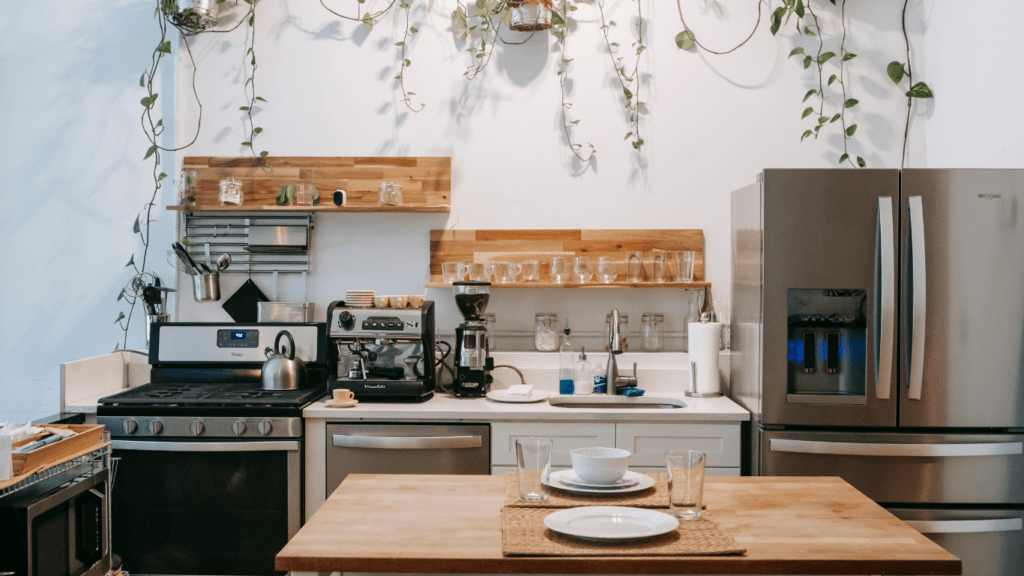Understanding The Space
Evaluating the room’s size and layout is essential before arranging furniture. Measure distances from walls to windows and doors to understand the usable space. Pay attention to traffic flow, ensuring people can move freely without obstacles.
Identify focal points like a large window or a prominent doorframe. Use these elements to guide furniture placement, emphasizing areas that draw attention naturally. Determine the room’s primary function, such as a living room or bedroom, to influence choices.
Consider how natural light enters the space. Place furniture in a way that balances light distribution, avoiding obstructions in front of windows. Opt for low-profile furniture beneath windows to maintain an open feel. For example, place a sofa opposite large windows to enjoy views without blocking light.
Take ceiling height into account when styling around doors. Higher ceilings allow for taller furniture pieces; lower ceilings necessitate more compact options. In areas near doors, leave enough space for doors to open fully without hindrance. Ensure placement allows for easy entry and exit.
Understanding each element of the space—from measurements to focal points—helps create a harmonious and functional layout.
Selecting The Right Furniture
Choosing the right furniture is crucial for creating a harmonious space around windows and doors. Consider style, size, and functionality to enhance the room effectively.
Choosing Pieces That Complement Windows
Match furniture styles with window design. If the window is contemporary, select sleek, minimalist furniture like a modern sofa or glass coffee table. For traditional windows, use classic wooden pieces. Position seating to take advantage of natural light. Place a reading chair or daybed near the window to create a cozy nook. Use low-profile furniture beneath windows. A low dresser or bench under a window keeps the view unobstructed and makes the room feel more open.
Selecting Furniture For Adjacent Doors
Ensure furniture allows free door movement. Place chairs, sofas, and tables a few feet away from doors to avoid blocking paths. Use multi-functional pieces like console tables, which can serve as both storage and a surface near doors. Avoid placing tall furniture next to doors. Tall bookshelves or cabinets can make the entryway feel cramped. Instead, use shorter pieces that provide storage without obstructing the door frame.
Placement Strategies
Strategic furniture placement enhances room aesthetics and functionality, especially around windows and doors. Let’s dive into specifics on aligning furniture with windows and arranging it around doorways.
Aligning Furniture With Windows
Position seating to maximize natural light. Chairs or sofas placed near windows create inviting spots for reading or relaxation. Opt for low-profile furniture beneath windows to avoid obstructing views and maintain an open feel. For example, use benches or console tables that sit below the windowsill height.
Consider symmetry when placing larger furniture items like bookcases or display units flanking the windows. This approach enhances balance and draws attention to the window as a focal point. Use lightweight window treatments like sheer curtains to amplify natural light while ensuring privacy.
Arranging Furniture Around Doorways

Ensure clear access around doorways to maintain easy movement. Keep larger furniture pieces, such as sofas or cabinets, at least a few feet away from doors to prevent cramped entryways. For multi-functional use, place console tables or benches adjacent to doors—these pieces can offer quick storage while keeping the space functional.
To balance aesthetics and traffic flow, avoid tall furniture near doorways. Such placement can make spaces feel confined and unwelcoming. Instead, use shorter pieces like side tables or low cabinets. Always check that doors can open fully without obstruction, so the movement remains unimpeded.
By focusing on these placement strategies, you can create a cohesive, functional space that highlights natural light and maintains smooth traffic flow around windows and doors.
Enhancing With Accessories
Accessories can elevate the overall ambiance in a room and emphasize architectural features. Incorporate window treatments and doorway accents to seamlessly blend style and functionality.
Window Treatments And Decor
Choose treatments that complement both the window style and the surrounding furniture. Use curtains or drapes for added elegance and select colors that harmonize with the room’s palette. Install blinds or shades for a minimalist look; these work well with contemporary furniture. Employ valances or cornices for traditional styles paired with wooden furniture. Ensure the length of curtains allows for natural light without overwhelming the space. Hang decorative items like:
- plants
- hanging lights
- art near windows
to draw attention to these areas.
Doorway Accents And Enhancements
Enhance doorways with functional and aesthetic elements. Place area rugs to delineate entry spaces and add a welcoming feel. Use sconces or overhead lighting to brighten the area around doors, ensuring accessibility and clarity. Hang mirrors opposite doors to reflect light and create an illusion of more space. Incorporate small consoles or entryway tables when space allows, offering a spot for keys or decorative items. Avoid overly large or tall items that can obstruct traffic flow and create a cluttered look. Use subtle hardware upgrades like stylish doorknobs or hinges to further enhance the doorway’s appearance.
Color Coordination
Color coordination is crucial to creating a cohesive look when styling furniture around windows and doors.
Harmonizing With Natural Light
Natural light can significantly impact how colors appear in a room. I choose lighter hues for furniture near large windows to make the most of natural light, enhancing the brightness. For example, white or light beige sofas and chairs work well, reflecting light and making the room feel airy. If the room receives intense sunlight, I incorporate faded colors like pastels or cool tones to calm the space while preventing glare. Darker furniture, like navy or deep green, complements rooms with less light, creating a cozier ambiance.
Coordinating With Door And Window Frames
Door and window frames shouldn’t be overlooked when coordinating colors. I ensure the furniture colors blend well with these frames for a unified look. If frames are painted white or neutral, bold or contrasting furniture colors like dark wood or vibrant fabrics can create a striking balance. Conversely, with wooden frames, I opt for furniture in complementary shades, like warm, earthy tones or natural wood finishes, to maintain a harmonious appearance. Such coordination aligns the room’s palette, enhancing both functionality and aesthetics.
Tips For Small Spaces
Arranging furniture in small spaces around windows and doors can be challenging yet rewarding. Efficient use of light and multifunctional furniture can transform a cramped room into a cozy haven.
Maximizing Light And Space
Integrate natural light to make small rooms appear larger. Place mirrors opposite windows to reflect light. Keep window areas clutter-free to allow maximum light penetration. Opt for sheer curtains to enhance brightness without sacrificing privacy.
Use smaller-scale furniture to maintain a sense of openness. Choose low-profile pieces, sofas, and tables to keep sightlines unobstructed. Floating shelves can serve as storage without occupying floor space. Paint walls in light colors to reflect light and give the illusion of a larger room.
Multifunctional Furniture Ideas
Invest in multifunctional furniture to extend usability in limited areas. A sofa bed provides seating by day and a sleeping area by night. Drop-leaf tables offer dining space when needed and compact storage otherwise. Ottomans with storage compartments serve as seating and hidden storage.
Consider furniture with built-in features. Desks with integrated shelving offer workspace and storage. Choose nesting tables that can be stored compactly but provide extra surfaces when needed. Sliding door cabinets are space-savers compared to those with swing doors.
Optimize every square inch to make the most of small spaces around windows and doors. Use these tips to create a more functional and visually appealing environment.
Common Mistakes To Avoid
- Ignoring Traffic Flow
Blocking paths with furniture disrupts room functionality. Before arranging furniture, I ensure there’s ample space for movement, particularly around windows and doors. For example, placing a large sofa directly in front of a doorway can obstruct access and create congestion.
- Neglecting Natural Light
Placing bulky furniture or tall items in front of windows hinders natural light. I avoid this by selecting low-profile furniture for window-adjacent areas. In one of my projects, I chose a low bench under a wide window to let in more light while providing seating.
- Overcrowding Small Spaces
Overstuffing small rooms with large furniture makes them feel cramped. Instead, I opt for smaller-scale pieces and multifunctional furniture. In tight spaces, I’ve used compact sofas or drop-leaf tables to maintain openness while maximizing functionality.
- Mismatched Styles
Combining clashing furniture and window styles can disrupt cohesiveness. I match furniture with window designs to achieve harmony. For instance, sleek, metallic pieces align well with modern windows, while traditional wooden furnishings complement classic windows.
- Overlooking Window Treatments
Misaligned window treatments can detract from a room. I select curtains or blinds that enhance both the windows and surrounding décor. When working on a minimalist room, I chose simple roller blinds to maintain a clean look while allowing controlled light.
- Blocking Doorways
Positioning furniture too close to doors can obstruct entry and exit. I keep furniture a few feet away from doors for a clear path. In one home, I moved a table away from the entry door, making the area more inviting and spacious.
- Inconsistent Color Schemes
A disjointed color palette can make a room feel chaotic. I coordinate furniture colors with window and door frames for a unified look. For example, I paired wooden frames with warm, earthy tones in a living room to create a cohesive atmosphere.
- Ignoring Scale and Proportion
Choosing furniture that doesn’t match the scale of windows or doors impacts balance. I ensure pieces are proportionate. In a room with oversized windows, I avoided tiny furniture and used adequately sized seating to maintain visual harmony.



 Betsylie Sheetsin – Home Renovation Expert
Betsylie Sheetsin serves as the Home Renovation Expert at Castle Shelf House, specializing in giving practical advice for both small and large-scale home improvements. With years of experience in construction and renovation, Betsylie understands the importance of blending durability with design. Her insights into home renovation projects, along with expert advice on the latest materials and techniques, empower homeowners to tackle even the most ambitious projects confidently.
Betsylie Sheetsin – Home Renovation Expert
Betsylie Sheetsin serves as the Home Renovation Expert at Castle Shelf House, specializing in giving practical advice for both small and large-scale home improvements. With years of experience in construction and renovation, Betsylie understands the importance of blending durability with design. Her insights into home renovation projects, along with expert advice on the latest materials and techniques, empower homeowners to tackle even the most ambitious projects confidently.
